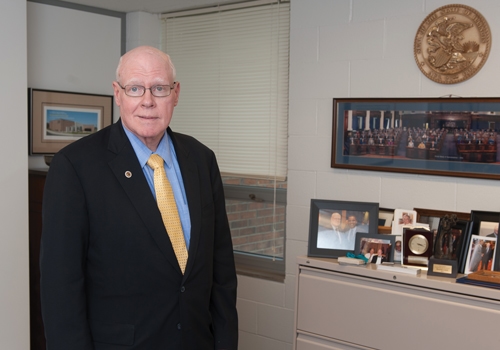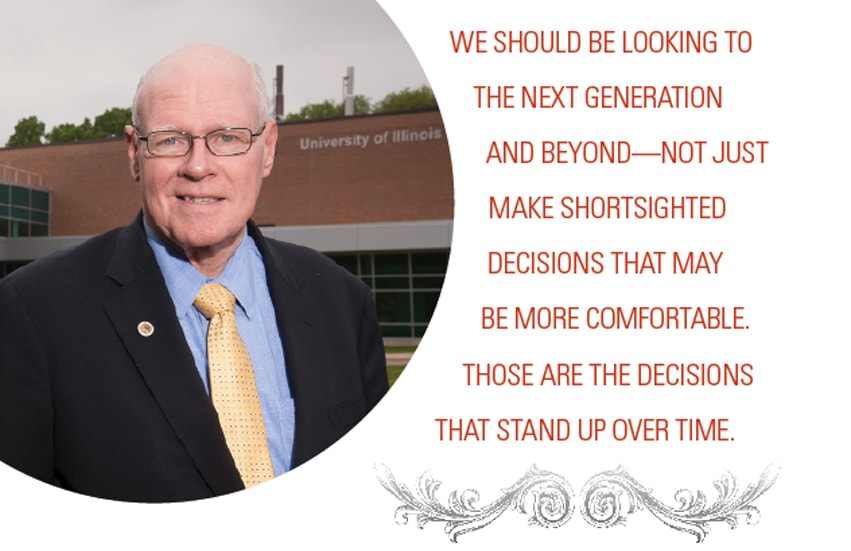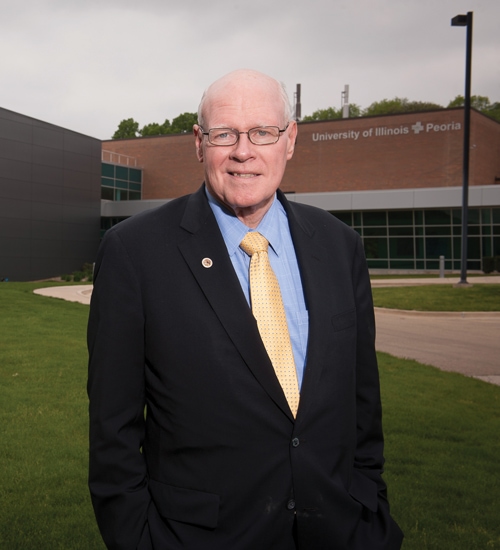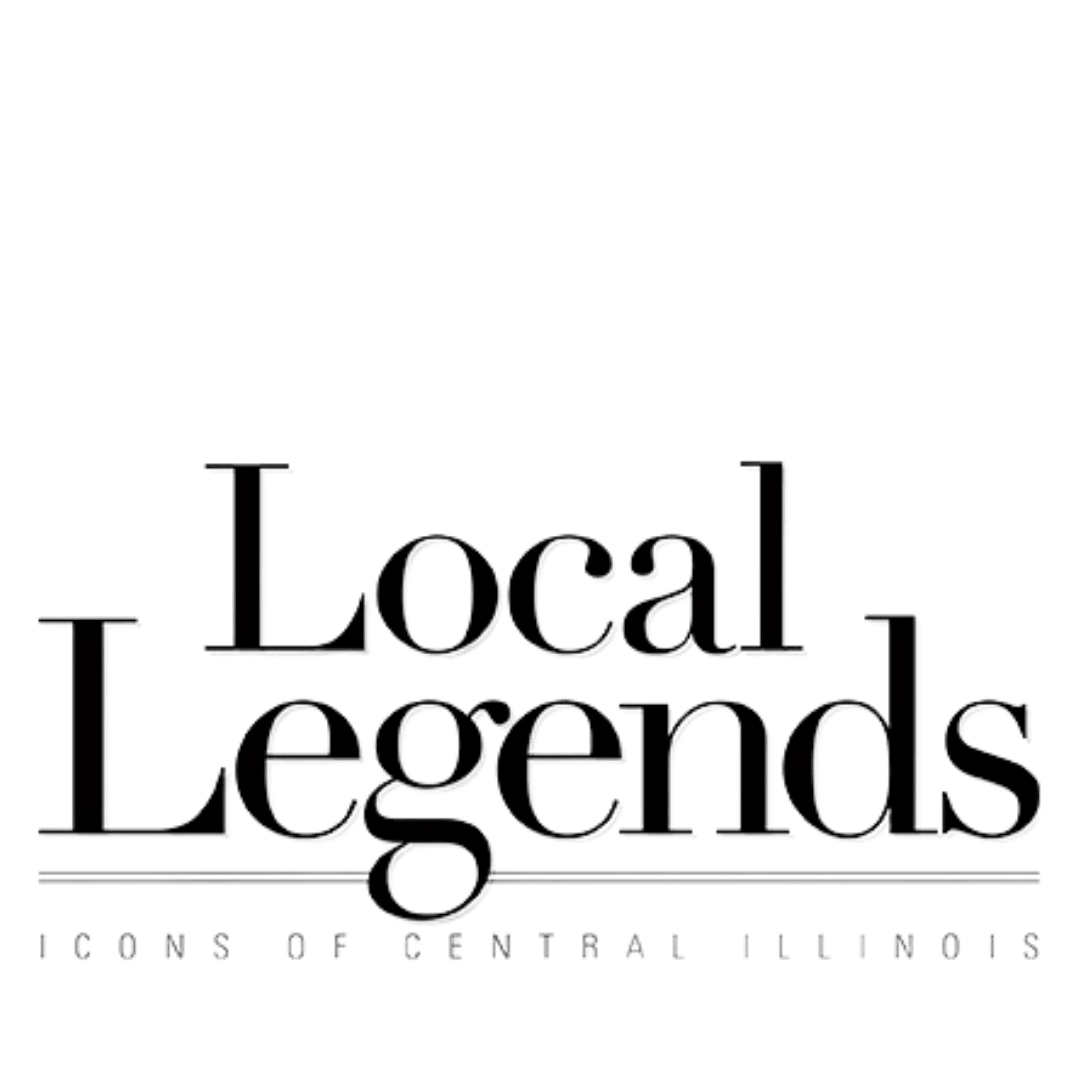Since 1989, Rep. David Leitch has served in the Illinois General Assembly with great distinction—a steady hand getting things done amidst an ever more divided and dysfunctional state legislature. Throughout his 13 terms, he has focused on constituent services, healthcare, economic development and human services, accumulating dozens of awards for his legislative work and community service.
After graduating from Kalamazoo College, the Michigan native became a full-time reporter for the Peoria Journal Star, covering city and state politics and general assignments. In 1974, he assumed leadership of the Peoria Downtown Development Council, working tirelessly with then-Mayor Dick Carver and a cadre of business leaders to revitalize downtown Peoria. The fruits of those efforts continue to reverberate today—from the creation of the Peoria Civic Center, to the siting of the Peoria School of Medicine (now the University of Illinois College of Medicine at Peoria), to the two-time resurrection of the Hotel Pere Marquette—setting the stage for current downtown efforts.
In 1980, Leitch launched a banking career that lasted 28 years, concurrent with his role as state legislator. After a brief stint in the Illinois Senate, he was elected to the House in 1988 and has remained there ever since, working his way up the leadership ranks. A champion for behavioral and mental health services, Leitch has worked tirelessly to reform Illinois’ “worst in the U.S.” mental health system and build a model community-based system in the Peoria area. He secured funding for the expansion of Illinois Central College—which renamed its Career Center in his honor—and has been a staunch advocate for people with disabilities while promoting a range of public health issues.
Among his greatest accomplishments, Leitch cites an early mammography bill and an umbilical cord blood stem cell law—the first of its kind in the country. He was also among a handful of prescient legislators to vote “no” on a 1989 bill that changed the annual COLA calculation—and set the course for Illinois’ ongoing pension crisis.
Leitch has served on a range of boards over the years, including the Heart of Illinois United Way, Heartland Community Health Clinic, Lakeview Museum and Susan G. Komen Foundation, among a dozen others. In 2017, he will retire after three decades of public service, his legacy in Peoria, Springfield and statewide secured—a true legend in his time.
Let’s start with your childhood. Are you a Peoria native?
I’m originally from Michigan… My father was the county agricultural extension agent. He grew up on a farm outside of Bad Axe, in the “thumb” of Michigan. He’s 100-percent Scottish. My mother was 100-percent Swedish—she grew up in the Upper Peninsula. At one time, I think I was related to most of the Swedes in Michigan. (laughs) [We] moved to East Peoria on my 16th birthday, so I started my junior year at East Peoria High School.
What were some of your hobbies as a kid?
I was extremely passionate about athletics. I was a reasonably good baseball player, and a more passionate—but not as gifted—basketball player.
What prompted the move to East Peoria?
My father was transferred. By then he was working as an agronomist for Ortho. He studied corn production… and held a lot of seminars on best practices in raising corn and other commodities.
So you grew up with an agricultural background?
Yes—agricultural and small-town. I spent my formative years in Hillsdale, Michigan. We lived in the shadow of Hillsdale College, which today is prominent for its conservative views… I lived between the campus and the Field House, so we were always very engaged with the football team. As kids, it was a big deal to have these friendships with real-life college football players.
How did you feel about moving to East Peoria?
We moved several times. I always found it interesting to move to another location and get more friends. My siblings and my mother did not enjoy moving so much, but I was very open to it.
So after graduating from East Peoria High School, you returned to Michigan?
I went right back to Kalamazoo College, which is where many of my friends were going. It’s a well-known and highly respected four-year liberal arts school in Michigan.

What was your major?
History. But I’m leaving out one of the transitional points in my life. In 1966, when I was a senior, I was given the [Peoria] Journal Star scholarship, so I became a copyboy in May of ’66. We used to help cut and paste papers and pull stories off the wire… That was very impactful. There is nothing more glorious than to be a newspaper reporter when you’re 19, 20, 21 years old! I thoroughly loved it.
Did you know you wanted to go full-time at the Journal Star after college?
I did. I started in June of 1970 full-time. I was a political reporter—City Hall and courthouse reporter, and general assignment… Then I was assigned to be with Bill O’Connell, who was among the most famous statehouse reporters in history from here. He was dean of the press corps. He knew more about what was going on—and was trusted by more people—than perhaps anyone before or since. He was a phenomenal mentor.
So jumping forward, when I went to Springfield—first as a senator, then as state rep—I had an enormous advantage having worked with Bill O’Connell… because I knew the rules. I knew the lobbyists; I knew a number of the members. I knew who you could trust and who you should stay away from. (chuckles) It was just invaluable.
Tell us about some of your biggest stories at that time.
There was a big murder… out by Jubilee State Park. Todd Gorsuch shot and killed a neighbor girl and his sister. That was October of 1970. It was a fascinating case, and very drawn out. My City Hall experiences were extremely interesting because [they] came during a very controversial part of our history. Mike O’Brien was our mayor prior to [Dick] Carver’s election [in 1973]. He went on to be a successful judge, but his period as mayor was very turbulent. Soaking in all this was just a fascinating experience.
Did you ever anticipate a political career?
Not really, but what happened… There was a very strong group of leaders led by David Connor, head of Commercial National Bank, and Bob McCord at Illinois Mutual. George Armstrong was our liaison from Caterpillar… Stan Bluestone and Tom Liston at Bergner’s, Harry Feltenstein at CILCO, and others. They were all very united in their desire to redo the downtown. They created the Downtown Development Council, a privately funded group to implement the downtown Peoria plan undertaken by [architect] Angelos Demetriou, who was phenomenal. He was one of a kind.
Anyway, as things proceeded, I became more and more interested in figuring out how to do things in the public arena. How do you go do a Civic Center—that’s been attempted five times prior to when it occurred? How do you implement [that] in the public arena—especially with all the differences between working in a public-sector environment as opposed to the private sector? It’s sort of like playing three-dimensional chess. That began to absolutely fascinate me—how you actually get things done. I’ve always been very focused on figuring out how to do things for our community… and within the state.
How did you end up as president of the Downtown Development Council?
They invited me. Bob Stevenson at Commercial National Bank had been assigned to it for a while. He was a very fine guy… but he didn’t feel comfortable in that role. So they took a chance on me, and I dove into it. I loved it.
What were some of the top priorities at that time?
That group was very determined to make Peoria the “capital” of downstate, in the words of Connor. They wanted Peoria to become a leading business/entertainment [hub]… and have the Civic Center. The Pere Marquette was my baby—[but] it shut its doors on January 1, 1979.
What happened?
It went broke. That was perhaps my most fun project: to resurrect it the first time. And then to work with [developer] Gary Matthews to do it again [in 2012]… I have a special place in my heart for the Pere Marquette. I think it’s very important to preserve those kinds of buildings in our community. It reopened in ’82, about the same time the Civic Center came online. Downtown was totally different then—it was a bunch of small shops. That whole area where [the Civic Center] sits represented a tremendous task by the city to relocate people and businesses to create the site.
What were some of the other pieces of that downtown puzzle?
When Carver was elected mayor… he was upset that the medical community had decided to build the new medical school out [north]… He believed it needed to be downtown, with the hospitals and the rest of the community.
He met with the new governor, Dan Walker, and I happened to be with him through all this. He persuaded Walker to take another look—even though they were already moving dirt. Governor Walker convened a meeting of the [Illinois] Capital Development Board in the auditorium of the downtown library. They decided to turn around the decision.
Then there was a huge fight with the University of Illinois, who were madder than hops that Carver was messing around with their decision. So that was a knock-down-drag-out. The mayor and Jerry Osborne, who was head of Urban Renewal, and Bob Wright, the city manager—they were able to accommodate the U of I, who said they had to deliver the site for the med school by a date certain, a goal they were confident could not be met. Well, they met it.
Unfortunately, in the midst of all that, the sacrifice was that the University of Illinois insisted that Big John’s Bar-B-Q be torn down. But what they considered an eyesore was actually an institution here. Big John and his Bar-B-Q were a very important part of the community fabric in those days. They had to relocate Big John, and the med school proceeded. But see, it’s a big kick to be involved in those things, especially when you’re not supposed to win. To figure out how to do something and work with other people who are a lot smarter than you are, like Carver… is very exhilarating, at least for me. It was tremendous fun. And look what they did.
The Civic Center, the College of Medicine…
Right. The [Peoria] Civic Center, for example, has three main parts: the arena, the exhibition hall and the theater. You can have three different events going on at one time. Nobody else has that. If you go to Springfield or Rockford or Quad Cities, those buildings—which were all built about the same time under the Civic Center Support Act—are just universal. They can have different functions, but they don’t do one function especially well. To me, that was one of the most important decisions Mayor Carver insisted on. He wanted to do it right or not do it. And look how that’s paid off over time.
He had the political courage to work with the City Council and do the right thing, even though it was controversial. I have great respect for that kind of leadership. We should be looking to the next generation and beyond—not just make shortsighted decisions that may be more comfortable. Those are the decisions that stand up over time.
Wasn’t there once a plan for a downtown mall?
Absolutely. One of the most prominent mall developers in the United States was the Taubman Company. Al Taubman was an innovator who created malls all over the country, and became a billionaire doing it. I met with him and his team many times. They very much wanted to do the mall downtown…
It would have been quite a spectacular thing. And we got very, very close to it, [but] we just couldn’t get there. Everything has to be right for one of these things to work, and the combination of problems just never quite tipped it over the edge. For example, Tom Liston retired and they had a new leader at Bergner’s… and he moved the company to Milwaukee. So, things like that.

We lost some key leaders…
Yes—and see, this is what happens. Things aren’t static while you’re sitting around trying to figure out how to do something. The economy will go south, or you may hit a period where it’s going well. It’s a moving target, which is part of the challenge.
Sometimes when things are well-intentioned but you can’t accomplish them, it’s because they shouldn’t be done. Maybe it was good it didn’t get done, but it was a huge disappointment at the time. And about that time, Carver had gone off to be Assistant Secretary of the Air Force, so the absence of his leadership contributed as well.
In my view, you need three elements to make economic development go. You need to have a strong, united business group that can make things stick. You need competent governance—a very competent, visionary group of public leaders who understand what is necessary to take important, long-term steps for the community. Third, it helps to have a very imaginative plan. And that plan will change.
When you embark on a journey to implement a plan, you quickly find out that you need a lot of course corrections. You learn, and you make decisions that are different than those envisioned when you were first doing the plan. You can then craft real solutions that would have never happened if you hadn’t started the journey in the first place. All of those dynamics are very, very fascinating.
How did you get into banking?
In 1980, [the Downtown Development Council] was winding down, and David Connor asked me to come work with him at Commercial Bank. He was going to try to create a holding company, which occurred, [but] it didn’t pan out the way he expected… Branch banking was outlawed [in Illinois] at the time, so a bill authorizing multi-bank holding companies was passed in 1983. There was a feeling that if banks didn’t get to a critical mass in size, they wouldn’t be able to compete or sustain themselves. I think people today, looking back, might challenge that idea.
Anyway, it was very exciting to create a holding company and to create a group of banks that became Midwest Financial Group. But [there were] internal frictions and a lot of strong personalities, and it blew up… So then it became First America, then National City, and now it’s PNC. I was involved with figuring out a lot of the ins and outs of putting together some of these programs.
You were briefly in the Illinois Senate, prior to the House. How did that come about?
Prescott Bloom died in January 1986, and I was appointed to fill out his term, but they didn’t appoint me in time to get my name on the [primary] ballot. So Carl Hawkinson, a state representative, challenged and defeated me in the largest write-in Senate primary in Illinois history. So I got appointed and then lost, but came back when [Rep.] Fred Turk decided to retire. He wanted me to succeed him, so I ran in 1988 and won.
Who was the biggest influence on you politically?
I always admired how [Dick] Carver could figure out how to do things. I think he is the most effective person in political life I’ve ever seen—at any level. He was by nature an eternal optimist. You have to be when everyone is saying no, no, no, you can’t, you can’t, you can’t. I benefited a great deal from his example.
David Connor was just plain smart. He was a very, very strong leader. Then I learned from Bill O’Connell the ins and outs of Springfield—I really can’t exaggerate how smart he was, and with all of his institutional memory. There were other people whom I’ve admired and don’t want to leave out, but I think first of those individuals because each had a piece of something important to learn when you’re setting about to practice these arts. (chuckles)
Tell us about that first run for the Illinois House.
I was a much better candidate by then. When I ran for Senate, I pretty much thought I knew everything there was to know, and the voters informed me otherwise. I wasn’t quite as arrogant the second time.
I was familiar with how to organize campaigns. I’d run Carver’s [mayoral campaign] and a number of City Council [races]… and I had invaluable help. David Ransburg and Ralph Converse were very, very instrumental. Fred Turk was one of the most respected people in the community, and I had his blessing. Camille Gibson was the [Republican] county chair—she was very strong in my corner. A number of people with whom I’d worked while I was with the Downtown Development Council were very enthusiastic. I couldn’t have done it without them.
What were some of the issues you focused on when you first got to Springfield?
One of my first bills was a mammography bill; I was a co-sponsor. For years, the insurance lobby had stopped insurance coverage for mammograms. I was fortunate to get it out of committee, where it had been bottled up.
Another thing I’m proud of: I voted against the three-percent compounding of the COLA [cost-of-living adjustment] in the pensions. Only five of us voted no. If you want to identify one of the major elements of our pension problem, it’s three-percent compounding without paying for it… I honestly recognized that at the time and believed once that passed, it was not if, but when these pensions were going to be in a world of trouble. Compound interest—I believe Einstein said it was the eighth wonder of the world. When it’s working for you, it’s marvelous. When it’s working against you, it’s devastating. And that’s where we are today.

How did your passion for mental health issues develop?
Among the reasons, my now-deceased brother… had always had bipolar issues, [though they were] undiagnosed. All through grade school, I grew up understanding a couple things. If only he could have been helped at an early age, what a huge difference it would have made. I also remember the total consternation, frustration and futility felt by my parents, because there was no way to get an understanding of what was going on and get on a path to deal with it. I just had a great empathy and understanding of the need to do better for people with behavioral and mental health issues.
The whole system is upside-down—instead of being focused at a community-based level, so if your 16-year-old starts acting peculiarly, you can go somewhere tomorrow, understand what’s going on, and get on a path to taking care of it. That should be the fundamental goal. Instead, at the state level, we have all these different silos. We have a Division of Mental Health; we have a Division of Alcoholism and Substance Abuse—even though 80 percent of serious and persistent mentally ill people are comorbid with drug abuse. Their licensure is different; their mandated rules from the state are different. Then you slather on top of that… the federal government, imposing whatever they think is important. You get this huge, bureaucratic mess, where any real, effective treatment is pretty much accidental.
We created… the Central Illinois Coalition for Mental Health Recovery, which was designed to bring together the community-based agencies and Methodist Hospital, which provided the psych beds, to… make sure there was high-level collaboration. Subsequently, we stayed together and continue to work together on a whole range of issues.
We promoted the Mental Health Court… [and] the psych residency at Methodist. There are only 5,000 child psychologists in the United States. By getting a psych residency here, it’s our hope
that we can grow a few of our own. Then under Jack Gilligan’s leadership, we promoted the [Community] Crisis Center, which is huge. We have to fight every day to keep it, but every community in the state should have [one] because… you can keep people out of the emergency rooms and out of jail. It’s an infinitely more rational system.
You’re also well known for constituent service. Tell us about your guiding philosophy there…
My philosophy is: someone’s number-one issue is the one biting them at any moment in time. It’s not what people think is on the front page. You can’t imagine all the different problems people have… and some of them are life and death. It’s important to give advocacy to people in the district—as much as it is to go to Springfield and legislate—and of course, Linda Daley [Leitch’s chief of staff] is the best in the state.
How has the General Assembly changed most over the years?
I tell members [today] they don’t know what it is to be a member because all their power has been taken away and consolidated with the Speaker, the floor leaders and the Governor. When I was first down there, we would have actual agency appropriation bills. We would work with our colleagues in Rockford, Springfield, Champaign or wherever to have real amendments to the budgets if we wanted something for our communities. Today, you get this three-pound budget dropped on your desk and you’re given an hour to have it jammed down your throat. Nobody would have put up with that 25 years ago, believe me.
When did you begin contemplating retirement?
I just started thinking it was time. It’s really not more complicated than that. I just started thinking I don’t want to be there when I’m in my 70s. I’m going to do something else.
What are your plans?
I have a lot of plans. My son lives out in New Mexico, and I have three grandchildren up near the Rockford/Belvidere area. My newest granddaughter is 18 months and just moved to the Boston area. So I’ll be doing some traveling. iBi






